
Ever dreamed of a vibrant garden without much space? The trend of home growing is on the rise, and a sustainable way to join in is by using PET bottles for vertical gardening. With them, you can create a space-saving hanging garden that’s good for the planet.
Picture harvesting fresh herbs or enjoying a blooming corner without taking up much room. That’s the magic of hanging planters made from recycled materials. This guide walks you through building your own, step by step, using PET bottles. Get ready to transform your space and grow some joy!
Why Choose Vertical Gardening with PET Bottles?
The benefits of vertical gardening with PET bottles are plenty. It’s eco-friendly, perfect for small spaces, and budget-friendly. Let’s dive into the details!
Sustainability and Creative Reuse
Repurposing PET bottles is a planet-friendly move. Instead of tossing them, you turn them into planters for your garden. This cuts down on waste and keeps plastic out of the oceans.
Did you know, per UN Environment data, over 8 million tons of plastic end up in oceans yearly? A PET bottle can take up to 450 years to break down in nature. By reusing them, you reduce this impact and support a greener future. Your vertical garden isn’t just pretty—it makes a difference!
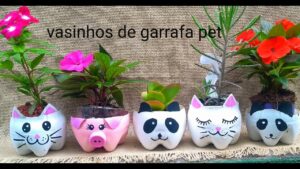
Space Optimization for Small Areas
Live in an apartment or small house? Vertical gardening is your answer! It uses vertical space, freeing up the floor. Hang it on a balcony, kitchen wall, or even a living room corner.
Imagine fresh herbs at your fingertips without needing a big yard. Studies show vertical growing can yield up to 10 times more per square foot than traditional methods. People worldwide are using this trick in apartments and tiny spaces, creating urban oases. Small in size, big in beauty!
Affordability and Accessibility
Setting up hanging planters with PET bottles is way cheaper than buying pots and plants from stores. You reuse items headed for the trash and save cash. Plus, organic soil and compost are affordable options.
Compare the costs: a medium plastic pot might run $3-$10, but a PET bottle is free! With creativity and simple supplies, you get a stunning garden on a budget. Research from agricultural experts suggests families can save up to $30 monthly by growing herbs and veggies at home. It’s a smart pick for nature lovers on a budget.
Materials Needed to Start Your Vertical Garden
To kick off your vertical gardening project, you’ll need some basic supplies. PET bottles, soil, tools, and seedlings are must-haves. Here’s the full list:
Materials List:
- PET bottles (various sizes)
- Scissors or utility knife
- Strong rope or wire
- Drill or hammer and nail
- Potting mix
- Small pebbles or expanded clay
- Seedlings or seeds
- Acrylic paint (optional, for decoration)
- Gardening gloves
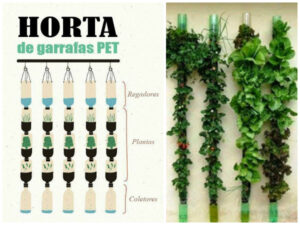
Choosing the Right PET Bottles
Pick PET bottles in different sizes for various plants. Two-liter bottles work great for most veggies, while 20-ounce ones suit herbs. Wash them thoroughly with soap and water to remove residue.
Remove labels and check for cracks or holes. Clear or light-colored bottles are best—they let light reach the roots. Clean, intact bottles set your garden up for success. Ready to start the transformation?
Soil and Nutrients: The Key to Thriving Plants
Your potting mix is where plants grow. Use a blend of:
- 50% garden soil
- 30% worm castings
- 20% sand or vermiculite for drainage
Add organic compost for nutrients. Good drainage prevents root rot—layer pebbles or expanded clay at the bottle’s base to help water flow. A well-prepared mix is the secret to healthy, happy plants.
Essential Tools for Setup
You’ll need scissors or a utility knife, rope or wire, and a drill or hammer and nail. Use tools safely to avoid mishaps—gloves protect your hands.
A drill makes holes for hanging. Scissors or a knife shape the bottles. No drill? A heated nail works too. Safety first!
Step-by-Step: Building Your Hanging Planters
Now, let’s build your hanging planters. It’s easier than it looks! Follow these steps for an amazing vertical garden.
Preparing Bottles and Making Planters
- Wash bottles with soap and water, removing labels and residue.
- Choose your planter style: horizontal (lying flat) or vertical (upright).
- For horizontal: cut a side “window,” leaving 0.5-1 inch at the bottom.
- For vertical: cut off the top third of the bottle.
- Make 4-6 small drainage holes in the base.
- Sand cut edges to avoid injury.
- Optional: paint with acrylic paint for sun protection and style.
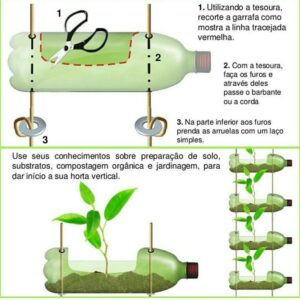
Pro Tip: For horizontal planters, keep the cap on! It controls drainage. Just poke a small hole in it to avoid water buildup.
Hanging System: How to Suspend Your Garden
There are several ways to hang your bottles. Pick what fits your space:
Method 1: Individual Hanging
- Drill two opposite holes near the bottle’s top.
- Thread rope or wire through the holes.
- Tie the ends to form a loop.
- Hang on hooks, clotheslines, or wall mounts.
Method 2: Integrated Vertical System
- Drill holes in each bottle’s base and cap.
- Run a strong rope through the center of all bottles.
- Tie knots or use large beads between bottles to hold them in place.
- Hang the full setup on a sturdy support.
Use rope, wire, or chains to hang securely, ensuring they can bear the weight of soil and plants. Test the setup’s strength before planting. A solid structure is crucial for successful vertical gardening with PET bottles.
Planting and Caring for Your Seedlings
- Add a layer of pebbles or expanded clay to the bottle’s base.
- Fill with potting mix to about 3/4 full.
- Dig a small hole for seedlings or sow seeds directly.
- Gently cover roots or seeds with more mix.
- Water lightly, avoiding over-soaking.
- Place the garden where plants get the right light.
Set your garden in a spot with good light, avoiding harsh midday sun, especially for herbs and leafy greens. Water regularly, keeping soil moist but not soggy. With care, your plants will thrive!
Picking the Right Plants for Vertical Gardening
Not all plants suit small pots. Choose compact species that thrive in limited space. Here are some top picks:
Herbs: Flavor and Freshness at Your Fingertips
Herbs are perfect for hanging planters—shallow roots and small sizes make them ideal. Great options include:
- Basil: Loves sun and frequent watering.
- Mint: Grows fast, suits larger bottles.
- Parsley: Tolerates partial shade, great for kitchens.
- Chives: Easy to grow, regrows after cutting.
- Oregano: Hardy and aromatic, needs little water.
- Thyme: Compact and fragrant, perfect for small bottles.
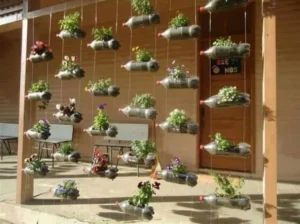
Water herbs regularly and harvest leaves when mature. They need 4-6 hours of sun daily, but not too intense. Regular trimming boosts new growth. With care, you’ll have fresh seasonings anytime.
Harvest Tip: Pick herbs in the morning when essential oils peak for max flavor and aroma in your dishes.
Compact Veggies: Mini Productive Gardens
Some veggies adapt surprisingly well to vertical gardening with PET bottles. Top choices are:
- Lettuce: Loose-leaf varieties suit small spaces.
- Arugula: Grows fast with shallow roots.
- Spinach: Nutrient-rich and versatile.
- Strawberries: Great for horizontal bottles, yields tasty fruit.
- Radishes: Quick to grow, ready in 3-4 weeks.
- Watercress: Loves moisture, ideal with good watering.

Plant seeds or seedlings in PET bottles and water consistently. Fertilize every two weeks with organic liquid feed for healthy growth. Soon, you’ll harvest your own veggies!
Ornamental Flowers: Beauty and Color in Your Hanging Planters
For a decorative vertical garden, these flowers thrive in PET bottles:
- Petunias: Colorful and hardy, bloom for months.
- Impatiens: Perfect for shade, abundant flowers.
- Pansies: Cold-tolerant, great for winter.
- Kalanchoe: Succulent with colorful blooms, low water needs.
- Geraniums: Tough and fragrant, love sunny spots.
- Marigolds: Repel pests and add vibrant color.
Plant seedlings in PET bottles, watering without wetting flowers. Remove faded blooms to encourage more. With care, your garden will charm and attract pollinators like butterflies and bees.
Tips and Tricks for Thriving Hanging Planters
To keep your hanging planters with PET bottles flourishing, follow these key tips. Watering, feeding, and pest control are essential:
Proper Watering: Avoiding Too Much or Too Little
Watering is critical. Water regularly but don’t soak the soil. Check moisture with your finger—if it’s damp an inch down, wait a bit.
Recommended Watering Frequency:
- Hot, dry days: 1-2 times daily.
- Mild days: every 1-2 days.
- Cold or rainy days: every 3-4 days.
Too much water rots roots; too little dries plants out. Watch your plants daily to find the sweet spot!
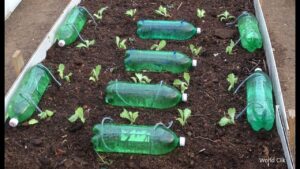
Watering Tip: Make a drip system with small PET bottles—poke tiny holes in the cap and place above plants for slow, steady watering.
Fertilizing and Nutrition: Keeping Plants Healthy
Fertilize every two weeks with organic feed or diluted NPK. Nutrients keep plants strong and productive. Follow package directions to avoid overdoing it.
Options include:
- Worm castings (great for organic gardens).
- Homemade compost (use fruit and veggie scraps).
- Castor cake (slow-release nutrients).
- Liquid fertilizers (easy for hanging setups).
- Banana peel tea (potassium-rich, boosts blooming).
Mix up fertilizers for balanced nutrition. Well-fed plants resist pests and diseases and yield more.
Pest and Disease Protection
Check plants often for pests like aphids, caterpillars, or scale. Use natural remedies to fight them without harming the environment or your health:
Effective Homemade Solutions:
- Soap Water: 1 tsp grated neutral soap per quart of water.
- Neem Oil: 1 tsp per quart of water with a few drops of dish soap.
- Garlic Spray: 4 crushed cloves in a quart of water.
- Pepper Spray: 1 hot pepper blended in a quart of water.
Keep your garden clean and airy to prevent pests and diseases. Remove yellowed or sick leaves pronto to stop spread. Plants like marigolds and basil naturally repel unwanted bugs.
Diversity helps too—avoid single-crop setups even in small spaces. With vigilance, your garden stays safe.
Crop Rotation and Maintenance
Even in small hanging planters, rotate crops. Don’t replant the same type in the same spot repeatedly—it prevents disease and soil depletion.
Every 3-4 months, or when swapping plants, refresh some soil. Add new compost and check drainage. Clean bottles occasionally to avoid algae or fungus buildup.
Frequently Asked Questions About Vertical Gardening
How long do PET bottle hanging planters last?
Exposed to sun, PET bottles last 1-3 years before getting brittle. Paint them with acrylic paint to shield from UV rays or place in less sunny spots for longer life.
Can I do vertical gardening indoors?
Yes! With enough light, indoor vertical gardening works great. Pick a spot near windows with 4-6 hours of daily light. Herbs like basil, mint, and chives thrive inside.
How do I stop PET bottles from yellowing?
To prevent yellowing, paint bottles with acrylic paint or wrap them in fabric, twine, or burlap. It protects the plastic and adds style to your garden.
Can I grow vegetables in hanging planters?
Small veggies like cherry tomatoes, mini peppers, and bush beans work in hanging planters with larger bottles (2L+) and proper support. Bigger crops like eggplant or zucchini aren’t ideal due to root space limits.
What’s the max weight for hanging planters?
A 2-liter PET bottle with wet soil and plants weighs 4-6 lbs. Ensure your hanging system (hooks, supports, ropes) can handle at least double that for safety. For multi-bottle setups, consult a pro.
Conclusion: Start Your Vertical Garden Today!
Vertical gardening with PET bottles is a creative, sustainable way to grow at home. It saves space, reuses materials, and adds beauty and freshness to your space. This guide gives you everything to get started.
The perks go beyond looks: you cut grocery costs for herbs and veggies, help the environment, and enjoy gardening’s therapeutic benefits. Studies show gardening reduces stress and boosts mental well-being—another reason to dive in!
Don’t wait! Start building your hanging planters today and reap the rewards of a vertical garden at home. It’s a green, healthy upgrade for your space.
Share pics of your garden on social media with #VerticalGardenAtHome to inspire others to grow their own. Join the growing community of urban gardeners!
Check out more decorating tips in our article packed with decorating ideas.
